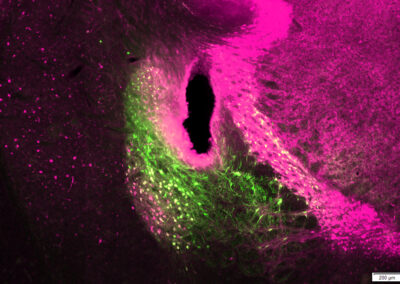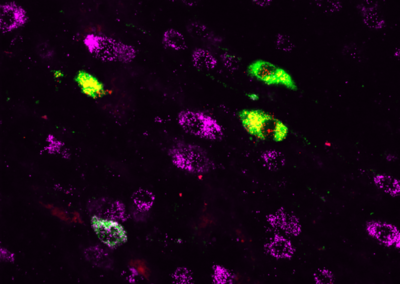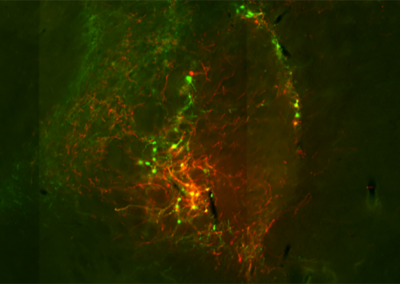RESEARCH
CARROLL PROJECT STEVENS/JOHNSON PROJECT SABATINI PROJECT GRANGER/JOHNSON PROJECT
SABATINI PROJECT
Sensitivity of Basal Ganglia-Cortical Circuitry
Many neuropsychiatric diseases with disorders of thought and cognition are now understood to have components of subcortical dysfunction.
The historically favored perspective that the cerebral cortex is the seat of thought and cognition, and that therefore perturbations of these processes arise from cortical dysfunction, is overly simplistic. Indeed, components of cognitive dysfunction in obsessive compulsive disorder (OCD), schizophrenia, autism, and bipolar disorder, including perturbed working memory, obsessions, compulsions, behavioral inflexibility, and altered risk-taking, have been linked to subcortical structures or to their close interactions with cortex. In particular, the basal ganglia and their dysfunction are implicated in the aforementioned disorders.
Fiber Photometry Recording in GPe
Parvalbumin neurons (magenta) express a calcium indicator, so calcium signals can be recorded via an implanted optical fiber in the mouse globus pallidus externus (GPe, green).
Molecular Characterization by RNAscope
Cortically-projecting neurons (green) in the mouse globus pallidus externus (GPe) are co-localized with genetic markers for cholinergic (red) or GABAergic (magenta) neurotransmission.
We will investigate the overarching hypothesis that basal ganglia projections to the cortex guide both the development of frontal circuits and their dynamics during decision making. Furthermore, we hypothesize that circuits between basal ganglia and cortex are sensitive to neuroimmune state, can modulate cortical microglia, and are altered in the pathogenesis or treatment of neuropsychiatric disease. This hypothesis is motivated by our recent discovery of activity-dependent maturation of synapses, cells, and circuits in basal ganglia–cortical loops, which would render these circuits sensitive to changes in activity caused by genetic and environmental challenges. Our research will examine the contribution of neuro-immune signaling and adolescence challenges on this circuitry in collaboration with the Carroll and Stevens labs. We will characterize the molecular, anatomic and physiologic properties of novel projections from the basal ganglia to cortex and determine their impact on cortical dynamics and behavior. In addition, given the extensive expression of cell surface receptors for neurotransmitters and neuromodulators on microglia and other immune and brain-border cells, we will examine how activity in the basal ganglia to cortex projections alters immune state in cortex. Lastly, by using assays that explicitly examine exploration/exploitation trade-offs, we will provide our collaborative labs in our Center a platform for the analysis of risk taking in the various disease and challenge models.



